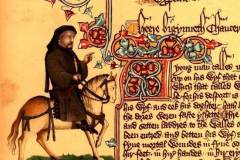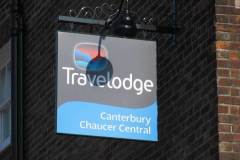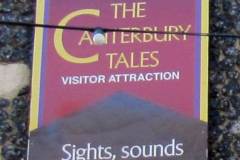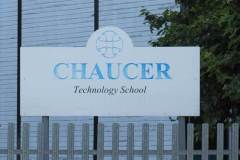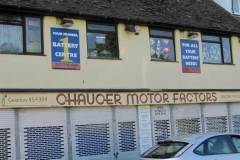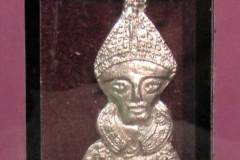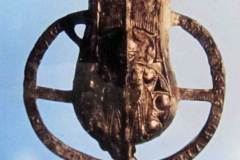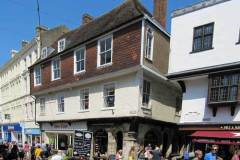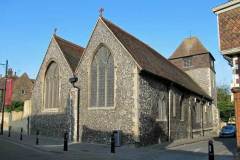(1343-1400) The Greatest English Poet of the Middle Ages
Chaucer is widely acknowledged to be the father of English literature, and his best known work, the Canterbury Tales (Image 1), describes a group of pilgrims telling stories whilst making their way to visit Becket’s shrine at Canterbury cathedral. Across the modern city, Chaucer’s name is widely associated with hotels (Image 2), exhibitions (Image 3), a college (Image 4), a hospital and businesses (Image 5). Street name associations abound – in addition to Chaucer Road, Chaucer Close and Chaucer Mews, we find Wife of Bath Hill, Pardoner’s Close, and many others linked to character appearing in the Canterbury Tales.
The city museum shows examples of pilgrim badges (Image 6) and necklace phials used for carrying supposed dilutions of Becket’s blood (Image 7) – both are mentioned in the Tales. No other individual name is stamped so indelibly on the face of the city.
Against this background, it is odd to find that unambiguous documentary evidence of Chaucer’s links to the city is hard to find. William Urry, academic and city archivist whose knowledge of local records was unmatched, concluded in his Thomas Becket his last days that “Chaucer and his party probably came [to Canterbury] in about 1385, at a time when the Becket pilgrimage had assumed the character of a tourist excursion”. The French historian Robert Foréville, a specialist in ecclesiastical history of this period, has suggested that Chaucer was amongst the large crowds who visited Canterbury for the 1370 celebrations which marked the 150 year jubilee of Becket’s translation (re-burial in the Trinity Chapel).
To summarise what is known:
- The pilgrims in the Canterbury Tales never actually reach Canterbury – the narrative stops at Harbledown, referred to jokingly as ‘Bobbe-up-and-doun’.
- The pilgrims do however arrive at Canterbury in the supplementary text ‘Tale of Beryn’, written by an unknown author in the 15th century. Here they lodge at the ‘Checker of the Hoop’ inn (Image 8 later known as Chequer of the Hope)
- Chaucer was Clerk of Works with responsibility for Canterbury defences – he surely needed to visit the city to oversee this work
- Chaucer became guardian to Edmund Staplegate in 1375. Edmund was from a Canterbury family with who owned property in the city, and is depicted in the west window of St Alphege church (Image 9).
- Chaucer travelled frequently to and from France delivering messages for the king. It is very likely that this would have involved stopping off in Canterbury
Sources: Brown (1990); Urry (1999)
Update: a statue of Chaucer was unveiled in 2018

